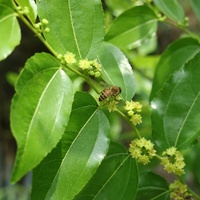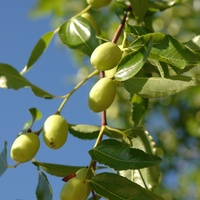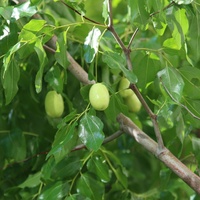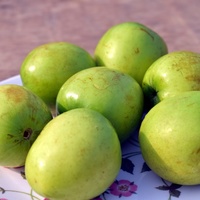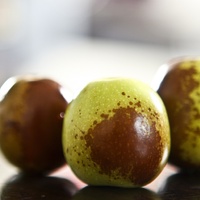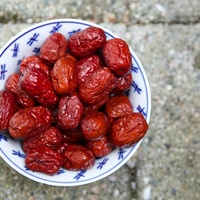Common name: Jujube
Other common names: Dounce, Chinee apple, Chinese date, Coolie plum, Crabapple, Indian jujube, Indian cherry, Indian plum, Masau, Taiwan apple
Description
Jujube is a fruit-bearing, fuelwood and shellac-producing tree originating from seasonally dry regions of Asia, its native range covering a vast area extending from inland South, Central and Northern India, to Burma (Myanmar) and China.
Previously, there were two distinct jujube species recognised, namely Ziziphus mauritiana and Ziziphus jujuba, but now botanists have united them under the latter name. There are, however, hundreds of jujube varieties, differing in plant height and shape, leaf shape and fruit shape, size, colour and flavour, as well as fruiting season. There is also much variation in the cold tolerance (hardiness) between the different varieties, with the least cold-tolerant being those originating in India and Burma (Myanmar) and previously grouped under Ziziphus mauritiana.
It is fast-growing and, depending on the variety and growing conditions, may form a shrub 1.5 to 2 m (5 to 6.5 ft) tall or a single-trunked tree up to 12 m (40 ft). Typically, it is a small 5 to 8 m (16 to 26 ft) tall tree with a stout trunk supporting a wide-spreading crown of thin, zig-zagging branches. The branches may be thornless or armed with short, sharp straight or hooked thorns.
The leaves are oval to elongated-oval, some with a pointed tip, small, from 2.5 to 8 cm (1 to 3 in) long, dark glossy green above, greenish-white and finely hairy underneath, and arranged alternately along the branches. They remain on the tree throughout the year, though some leaf fall occurs in areas with an extreme cold or dry season.
The flowers are tiny, star-shaped, green-yellow and arise in clusters of a few at the leaf axis. They bloom during the warm months of the year, either spring, summer or autumn, depending on the variety and local climate.
The fertilised flowers develop into small oval to round fruit, 1.5 to 2.5 cm (0.6 to 1.0 in) in diameter, with glossy green skin when young, becoming first yellow-green then brownish when ripe. They start ripening from summer to winter and have crisp, white, sour or sometimes sweet, slightly astringent pulp surrounding a small stone with usually two seed inside.
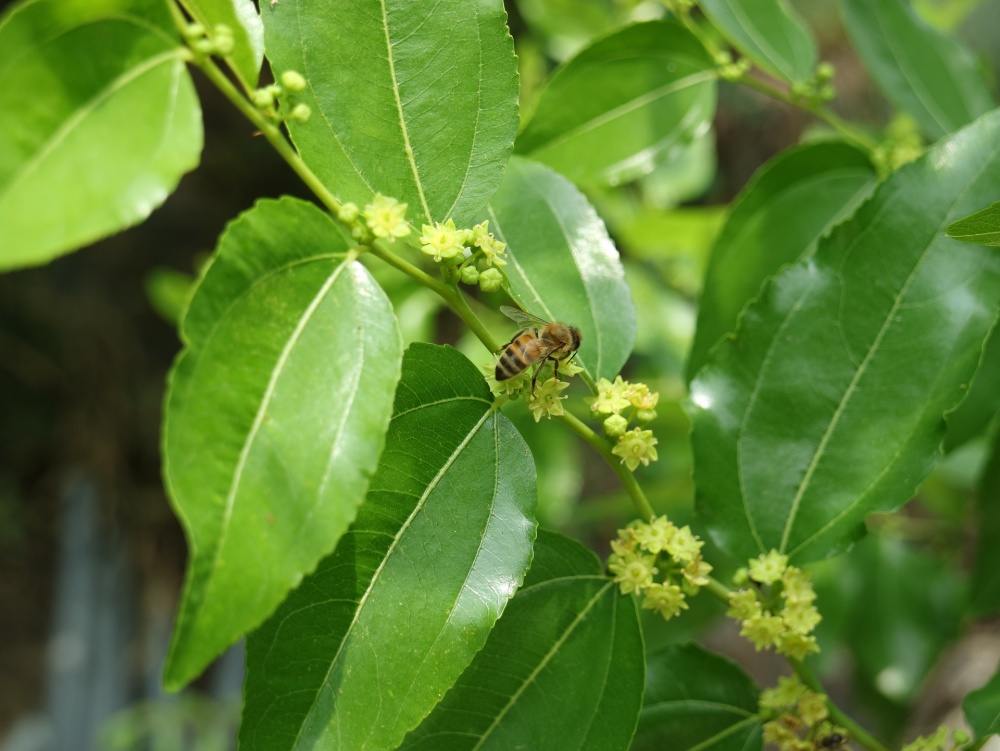
Photo by eyeccok from Pixabay
Use
The round fruit resemble a small apple or crabapple, and the crisp white pulp adds to this likeness. When fully ripe, they lose their crispness, becoming soft and less juicy, even somewhat floury. For eating fresh out-of-hand, they are best when slightly underripe. Jujube fruit are also juiced, pureed, made into jam and chutney, preserved in syrup and dried. The oval types are often likened in appearance and taste to dates from the Date Palm (Phoenix dactylifera). Jujube farmers in Australia have also started using the fruit to make branded Jujube beer and vinegar products.
The pulp contains high concentrations of 'Tartaric Acid', a natural plant acid extracted for manufacturing 'Cream Of Tartar', which has a range of uses, including as a natural bleaching agent in cleaning products.
Jujube is an important host tree for the Lac insect (Kerria lacca), a sucking insect that attaches in large numbers to the young stems to feed on the sap, excreting a sticky resin from their bodies as they feast, commonly known as 'Shellac'.
The Shellac is periodically collected and processed into a high-gloss, natural varnish, traded under the same name. The varnish is made by mixing the Shellac with a solvent, such as alcohol and is used for varnishing wood, especially high-value, antique wood furniture and musical instruments. It is also used for giving hard candy, pills and fruit a waxy coating and nail polish its shine and durable coating properties. A red dye extracted as a by-product of Shellac production has a history of use as a commercial textile dye and food colouring.
Other major lac host-trees include Flame of the Forest (Butea monosperma), Ceylon Oak (Schleichera oleosa) and Cutch (Senegalia catechu).
Jujube is also an important fuelwood tree, particularly in the more arid regions of its native range, such as in the state of Rajasthan, in India. The wood is hard, heavy and has a caloric value of around 4,900 kcal per kg. It is used as firewood and for making charcoal.
Jujube is reported as a major honey tree in China and Pakistan. The honey is amber to yellow-brown, very sweet and slow to granulate.
In its native range, the leaves and fruit are eagerly browsed by goats and camels, and the branches are sometimes lopped for feeding to livestock. The leaves have a crude protein content of around 13 to 17% of their dried weight.
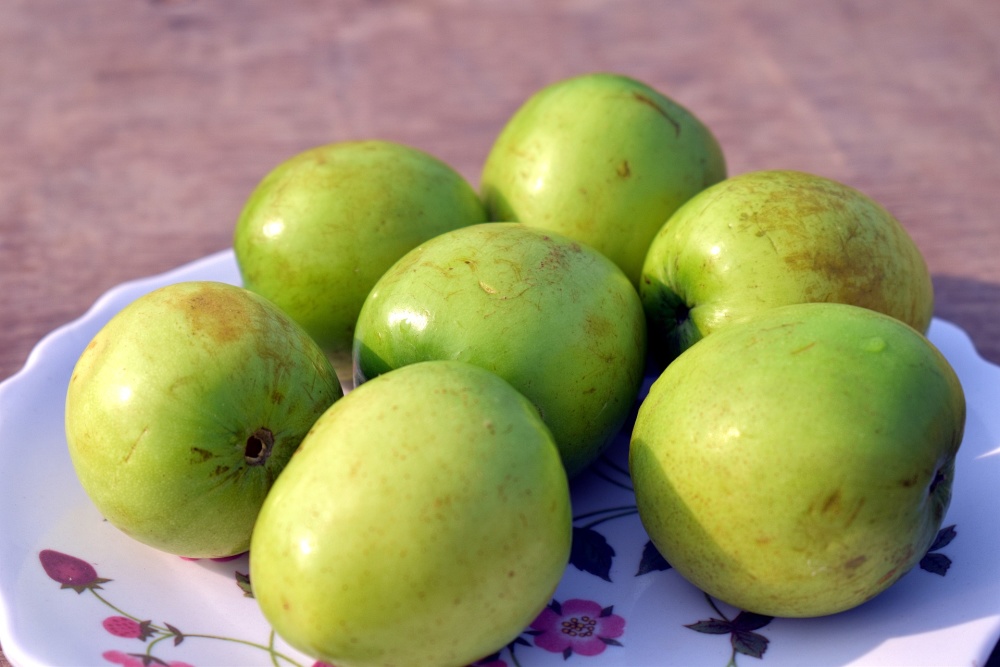
Photo by SandeepHanda from Pixabay Climate
General interest
Together with other drought-tolerant species, Jujube trees are being planted in significant numbers in the Sahel region of North Africa to create what is known as the 'Great Green Wall', an Africa-led initiative against the encroaching Sahara Desert.
The goal is to create a multi-species belt of vegetation across the African continent, spanning over 7,000 kilometres (4350 miles) east to west and 15 kilometres (9 miles) in width. Other species identified as being suitable for the project include Desert date (Balanites aegyptiacus), Gum arabic (Senegalia senegal) and Gao tree (Faidherbia albida).
Climate
Grows naturally and produces flavoursome fruit in sub-humid to moderately humid warm-temperate, Mediterranean, subtropical and tropical climates, generally areas with annual lows of 6 to 26°C, annual highs of 19 to 37°C, annual rainfall of 300 to 2000 mm and a dry season of 4 to 8 months, extending to 12 months with irrigation or groundwater.
Although Jujube grows well and is productive in cool climates, the fruit may not fully ripen in areas where the average high of the warmest month is below 28°C (82°F).
Growing
New plants are usually started from suckers or seed, which remain viable for up to two years under cold, dry, air-tight storage. Seed collected for sowing begins with harvesting ripe fruit, extracting the stone from the pulp and then sun-drying it for around two days. After drying, it is either stored away or cracked and soaked seed intact in cold water for a couple of days before sowing.
Pre-soaked stones are sown in containers with a free-draining potting mix, and the seedlings tended in a nursery until they reach planting size when about 30 cm (1 ft) tall or 5 months old. Although two seedlings may arise from a stone, only the more vigorous is kept. Planting in the ground is carried out at the start of the rainy season.
Performs best on free-draining loam, sandy-loam and loamy-sand soils of a moderately acid to alkaline nature, generally with a pH of 5 to 8, and on sites with full sun exposure.
Seedlings develop a long and deep taproot, making the plant highly drought tolerant.
Jujube trees are usually pruned short to make harvesting easier. This is best undertaken in the dry season after the fruit are harvested and before flowering starts.
Yields for orchards in India range from 50 to 80 kg (110 to 175 lbs) of fruit per tree per year, cultivated in dry areas under rainfed conditions.
Some of the main Jujube varieties include:
'Li', - Large oval fruit, crisp flavoursome pulp, fresh fruit, maturing mid- to late-season;
'Shanxi Li' - Large round fruit, sweet, crisp pulp, fresh or for drying, maturing mid-season;
'Lang' - Large pear-shaped fruit, crisp flavoursome pulp, fresh or for drying, maturing mid- to late-season;
'Chico' - Round fruit, similar shape to a small apple, crisp pulp, fresh fruit, maturing early- to mid-season;
'Thornless' - Oval to pear-shaped fruit, deep red skin, fresh or for drying, maturing mid-season;
'Suimen' - Elongated oval fruit, for drying, maturing mid- to late-season;
'Tarjan' - Large pear-shaped fruit for drying, maturing mid- to late-season.
Problem features
In its native range, birds such as pigeons, peahens and peacocks eat the fruit and scatter the seed.
Jujube produces suckers freely from the roots, which over time can lead to the formation of dense, impenetrable thickets.
The sharp thorns can inflict injury on the unwary.
Where it grows
References
Books
-
Adams, C. D. 1972, Flowering plants of Jamaica, University of the West Indies, Mona, Greater Kingston
-
Allen, B. M. 1967, Malayan fruits : an introduction to the cultivated species, Donald Moore Press, Singapore
-
Booth, F. E. M. & Wickens, G. E. 1988, Non-timber uses of selected arid zone trees and shrubs in Africa, Food and Agriculture Organization of the United Nations (FAO), Rome
-
Bradbear, N. 2009, Bees and their role in forest livelihoods : a guide to the services provided by bees and the sustainable harvesting, processing and marketing of their products, Food and Agriculture Organization of the United Nations (FAO), Rome
-
Brady, G. S. & Clauser, H. R & Vaccari, J. A. 2002, Materials handbook : an encyclopedia for managers, technical professionals, purchasing and production managers, technicians and supervisors, 15th ed., McGraw-Hill, New York
-
Crane, E., Walker, P. & Day, R. 1984, Directory of important world honey sources, International Bee Research Association, London
-
Editors of Sunset Magazine 2012, The New Western Garden Book: The Ultimate Gardening Guide, 9th edition, Sunset Publishing Corporation, California
-
Food and Agriculture Organization of the United Nations (FAO) 1988, Traditional food plants : a resource book for promoting the exploitation and consumption of food plants in arid, semi-arid and sub-humid lands of eastern Africa, Food and Nutrition Paper No. 42, Rome
-
Francis, J. K. 1998, Tree species for planting in forest, rural, and urban areas of Puerto Rico, U.S. Department of Agriculture, Forest Service, International Institute of Tropical Forestry, Río Piedras, Puerto Rico
-
Francis, J. K. and Liogier, H. A. 1991, Naturalized exotic tree species in Puerto Rico, General technical report SO-82, USDA Forest Service, Southern Forest Experiment Station, New Orleans
-
Gilman, E. F. 1997, Trees for urban and suburban landscapes, Delmar Publishers, Albany, New York
-
Gohl, B. 1981, Tropical Feeds : feed information summaries and nutritive values (Revised edition), Food and Agriculture Organization of the United Nations (FAO), Rome
-
Hocking, D. 1993, Trees for drylands, International Science Publisher, New York
-
Howes, F. N. 1949, Vegetable gums and resins, Chronica Botanica Company, Waltham, Massachusetts
-
Jensen, M. 1999, Trees commonly cultivated in Southeast Asia : an illustrated field guide, 2nd ed., Food and Agricultural Organisation of the United Nations (FAO) Regional Office for Asia and the Pacific (RAP), Bangkok
-
Khan, I. A. & Abourashed, E. A. 2010, Leung's encyclopedia of common natural ingredients : used in food, drugs and cosmetics, 3rd edition, Wiley Publishing, Hoboken, New Jersey
-
Kirk, T. K. 2009, Tropical trees of Florida and the Virgin Islands : a guide to identification, characteristics and uses, 1st ed, Pineapple Press, Sarasota, Florida
-
Krishen, P. 2006, Trees of Delhi : a field guide, Dorling Kindersley Publishers, Delhi
-
Luna, R. K 1996, Plantation trees, International Book Distributors, Dehradun, Uttarakhand
-
Martin, F. M., et al. 1987, Perennial edible fruits of the tropics : an inventory, U.S. Dept. of Agriculture (USDA), Agricultural Research Service, U.S. Government Printing Office (GPO), Washington, D.C.
-
Mollison, B. 1993, The permaculture book of ferment and human nutrition, Tagari Publications, Tyalgum, New South Wales
-
Nair, P. K. R. 1993, An introduction to agroforestry, International Centre for Research in Agroforestry (ICRAF), Kluwer Academic Publishers, Dordrecht
-
National Research Council (Board on Science and Technology for International Development) 1980, Firewood crops : shrub and tree species for energy production (Volume 1), The National Academies Press, Washington D. C.
-
Page, P. E. 1984, Tropical tree fruits for Australia, Queensland Department of Primary Industries (QLD DPI), Brisbane
-
Parrotta, J. A. 2001, Healing plants of peninsular India, CABI Publishing, Wallingford, Oxfordshire
-
Prasanna, P.V. 2012, Trees of Hyderabad: A Pictorial Guide, 1st ed., Botanical Survey of India (BSI), Indian Government Ministry of Environment and Forests, Kolkata
-
Randall, R. P. 2002, A global compendium of weeds, R.G. and F.J. Richardson Press, Melbourne
-
Randall, R. P. 2007, The introduced flora of Australia and its weed status, Cooperative Research Centre for Australian Weed Management, Glen Osmond, South Australia
-
Schafer, Peg & Foster, Steven, 1957- & Fannin, Sean 2011, The Chinese medicinal herb farm : a cultivator's guide to small-scale organic herb production, Chelsea Green Pub, White River Junction, Vt
-
Selvam, V. 2007, Trees and shrubs of the Maldives, Food and Agriculture Organisation (FAO) RAP publication (Maldives), Thammada Press Company Ltd., Bangkok
-
Sheikh M. I. 1993, Trees of Pakistan, USAID Forestry Planning and Development Project, Pictorial Printers, Islamabad
-
Singh, R. V. 1982, Fodder trees of India, Oxford & IBH Publishing Company, New Delhi
-
Tredgold, M. H. 1986, Food plants of Zimbabwe : with old and new ways of preparation, Mambo Press, Gweru, Zimbabwe
-
Troup, R.S. & Joshi, H. B. 1975 to 1981, Silviculture of Indian Trees (3 volumes), Government of India Publications, New Delhi
-
Winter, R. 2009, A consumer's dictionary of cosmetic ingredients : complete information about the harmful and desirable ingredients found in cosmetics and cosmeceuticals, 7th ed, Three Rivers Press, New York
Articles, Journals, Reports and Working Papers
-
Morton, J.F. 1964, Honeybee Plants of South Florida, Proceedings of the Florida State Horticultural Society, Vol 77:415-436.
-
Subhadrabandhu, S. 2001, Under-utilized tropical fruits of Thailand, Food and Agriculture Organisation of the United Nations (FAO), Regional Office for Asia and the Pacific (RAPA), Bangkok
